When Gainesville High School teacher Sadie Matteucci wanted her students to learn more about the benefits of composting, she knew where to go. She took a group of environmental science students to Dr. Ann Wilkie’s lab at the University of Florida. Wilkie is the lead professor at the UF/IFAS department of soil, water, and ecosystem sciences’ (SWES) Experiential Learning Lab at the BioEnergy and Sustainable Technology Laboratory (BEST Lab). She visited Matteucci’s classes in the fall to teach about the sustainable practices of reducing food waste and revitalizing soil. Now, she was going to give the 9th graders a close-up look at the UF Student Compost Cooperative (SCC). The early February field trip also included discussions of bioenergy crops and gardening as part of the tour of Wilkie’s Experiential Learning Lab.
“Dr. Wilkie did a great job explaining composting in our classroom,” Matteucci said, “but I wanted these students to see firsthand the beginning-to-end process and how she does it here.”
Matteucci’s classes have started garden beds at GHS this spring and will be planting different vegetables, herbs, and flowers in them. Part of the process is incorporating compost into the mix – compost they will produce from their own food scraps. Wilkie started the SCC 15 years ago. The goal is to reduce food waste on campus and to get students, and the UF community, to embrace sustainable practices. The students in the SCC use the compost in their on-site garden plots.
“For these students – 14 and 15 years old – to learn about composting and take that to their school and into their homes, is great,” Wilkie said. “It’s something they can teach their friends and their families.”
Bioenergy Crops
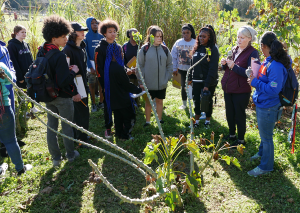
Adjacent to the composting bins and student gardens is a stand of tall grasses. These are the bioenergy crops: sugarcane, syrupcane, energycane, and Napier, or elephant, grass. Towering over the students at more than 8 feet tall, these are fermented to produce energy.
“Grasses like these can be harvested and processed, fed to microorganisms, and that process can create biogas or bioethanol,” Wilkie explained. “These perennial grasses can be harvested again and again to provide renewable energy.”
The students took an interest in another energy crop, a shrub or small tree called Jatropha. It produces a walnut-size fruit with seeds that have a high oil content. That oil can be used to make biodiesel.
“It’s cool these little seeds have oil that can provide power to things,” one student said.
Research at the Experiential Learning Lab
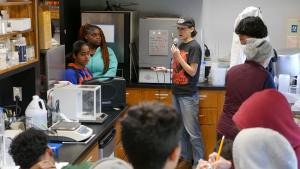
Dr. Wilkie next brought the students to the lab buildings where UF students she mentors conduct their research. Undergraduate students who want experience outside the classroom can conduct research in these Experiential Learning Lab facilities. They can explore an area of sustainability they are passionate about and learn how to design and carry out research.
“It’s one thing to read about the science in a textbook or a journal article,” Wilkie said, “but it’s a true learning experience to pose your own question, do the research, see the results, and write up the findings.”
Two of her undergraduate students were in the lab and talked about their research work. Duane Hardy is in his second semester of exploring different microbial additives that may speed up the process of composting. Katya Kasprzak is just beginning her research into bioenergy crops.
“Most of these GHS students have not been in a working laboratory at UF, so this is a great opportunity for them to see how science works in the real world,” Matteucci said.
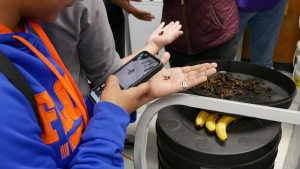
The SCC also practices vermicomposting or composting using worms, which is different than traditional composting in many ways. While traditional composting uses primarily microorganisms, vermicomposting relies on worms consuming organic matter. The worms generally only feed on food waste, paper, and more degradable materials, but not yard waste.
Vermicomposters are generally not mixed. Instead, the worms migrate to the fresh material. The units do not heat up, because high temperatures can kill the worms. While you can find common earthworms in a traditional composter, vermicomposting uses different species of earthworms, such as red wigglers or nightcrawlers. These are better adapted to smaller environments with a high amount of organic material.
The end product is worm castings rather than compost. These castings are the excretion from the worms and look like little brown balls. Compared to traditional compost, worm castings typically have increased nutrient availability and increased biological interactions with plants’ root systems.
Ask a Scientist
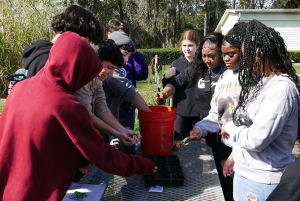
Finally, the students planted some snap pea seeds they brought, using soil and compost from the SCC. They also enjoyed hot chocolate, cooked with biogas, on the chilly February morning and were able to “ask a scientist” questions. They asked Dr. Wilkie various questions on a range of topics. For example:
- When will fossil fuels run out?
- Can we grow all the food we need locally?
- How can we start composting food waste at our school?
In addition to the question-and-answer session, the students left comments about what they liked and learned during the field trip:
- My favorite part was holding the worms.
- One of the things that I learned about was the energy crops and how they’re used for biogas.
- I loved seeing inside the laboratory.
- I learned worms are used to help grow plants.
- I enjoyed trying to identify the plants in the garden.
“This was an incredibly valuable experience for my students,” Matteucci said. “I appreciate Dr. Wilkie and her students for spending time with my students.”
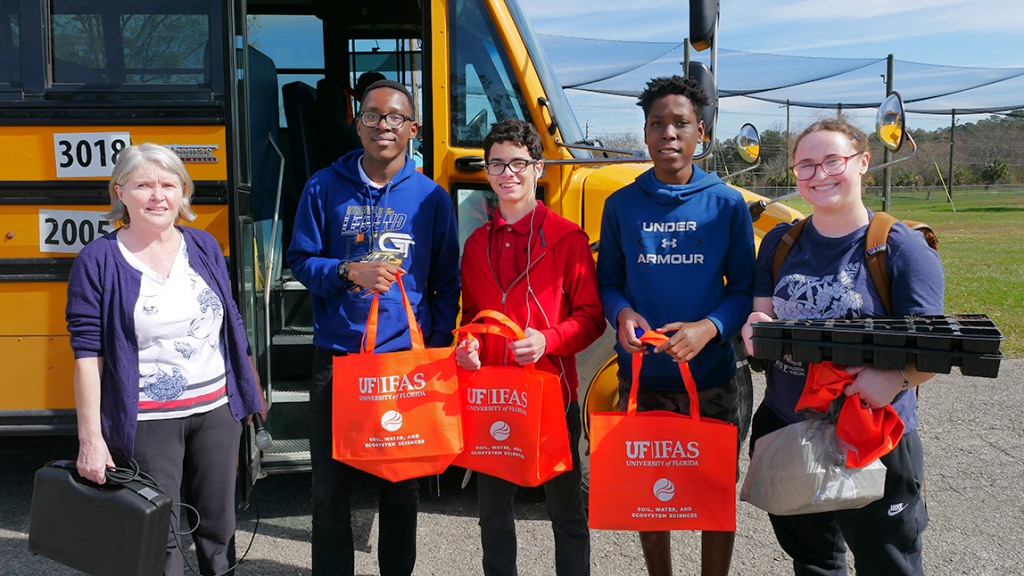
 2
2
